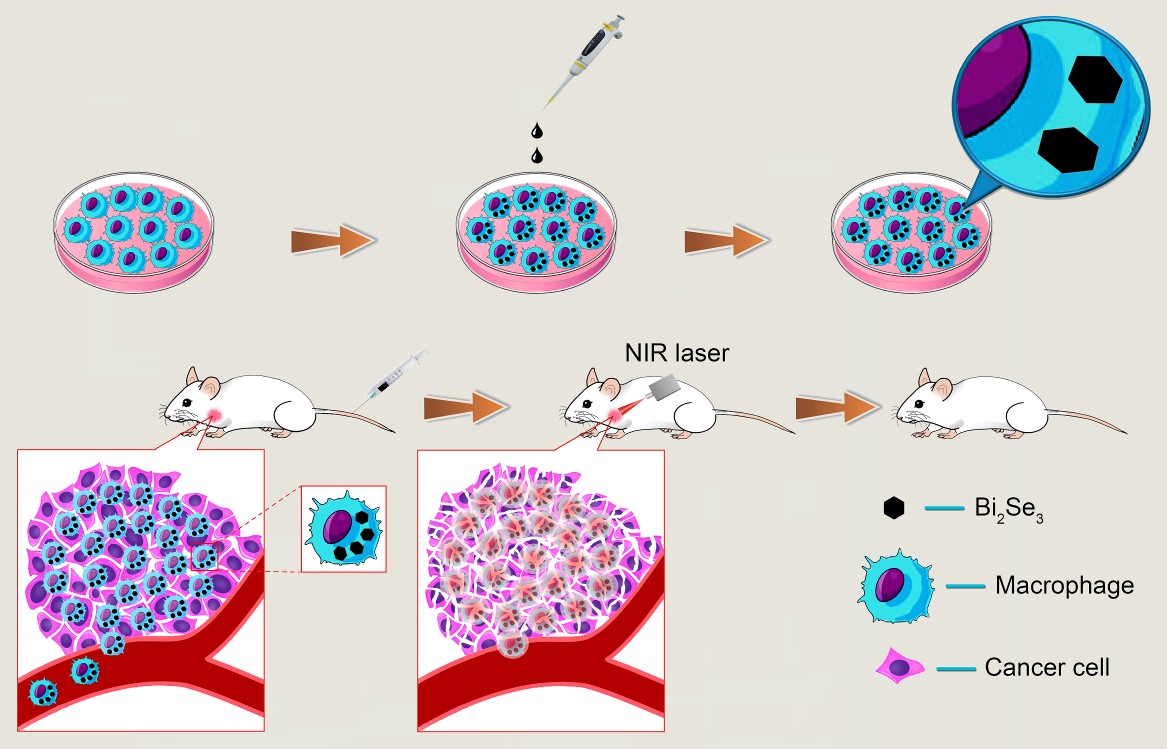SIAT Establishes a Cell-Borne 2D Nanomaterials Delivery Strategy for Efficient Cancer Targeting and Photothermal Therapy
Date:19-07-2017 | 【Print】 【close】
As a new class of nanomaterials, two-dimensional (2D) nanomaterials are promising photothermal therapy (PTT) agents on account of their intriguing physical and chemical properties. Many types of 2D nanomaterials such as graphene, reduced graphene oxide (rGO), MoSe2, Bi2Se3, and black phosphorus (BP) have recently been explored for in vitro and in vivo PTT of cancer. In comparison with other types of PTT agents, 2D nanomaterials generally have large near-infrared (NIR) extinction coefficients with little scattering and excellent photothermal stability without undergoing shape transformation upon irradiation with a high-power NIR laser. Moreover, the large surface area of 2D nanomaterials offers plenty of space to engineer a variety of multifunctional nanocomposites suitable for drug delivery and cancer theranostic applications.
2D-nanomaterials-mediated PTT generally involves delivery of nanomaterials to the tumor and subsequent light irradiation to produce a high local temperature. It is critical to distribute the nanomaterials evenly at an effective concentration throughout the tumor because nanomaterials cannot functionalize as designed if they do not accumulate at the diseased tissues at a sufficiently high concentration. As a common strategy in tumor targeting, the size and surface properties of the nanomaterials are modulated so that they can be passively delivered into tumors by the enhanced permeability and retention (EPR) effect. Nonetheless, the tumor tissues have poorly vasculatures and lymphatic capillary networks, leading to nanomaterials inadequate accumulate in the hypoxic tumor region. In this respect, development of new 2D PTT agents is highly desirable in order to improve the tumor-targeting efficiency in cancer therapy.
Since common drugs or nanomaterials delivered in human body often fail to reach many areas, the cell mediated strategy is attractive in therapeutic applications as the nearly impermeable biological barriers can be effectively circumvented. Recently, the research group led by Prof. YU Xuefeng and Prof. WANG Huaiyu at Shenzhen Institutes of Advanced Technology, Chinese Academy of Sciences, have establishes a cell-borne 2D nanomaterials delivery strategy for efficient cancer targeting and photothermal therapy. The research group member Dr. Zhibin Li’s study demonstrated that the cell-mediated therapy by transporting 2D Bi2Se3 nanosheets within macrophages after intravenous injection show prolonged blood circulation and can overcome the hypoxia-associated drug delivery barrier to target the tumor efficiently and dramatically enhance the efficiency of photothermal cancer therapy. The Bi2Se3-laden-macrophages possess good biocompatibility as demonstrated by the biochemical and histological analyses and furthermore, most of the materials are excreted from the body within 25 days. The findings reveal a desirable system for highly efficient near-infrared photothermal cancer therapy. Their research has been published online by Biomaterials
( http://doi.org/10.1016/j.biomaterials.2017.04.012).
This work was supported by the National Natural Science Foundation of China (51672305, 81501592), Science and Technology Basic Projects of Shenzhen (JCYJ20150401145529032, JCYJ20120615124830232), China Postdoctoral Science Foundation funded project (2016T90807, 2015M582445), Guangdong Natural Science Foundation Doctoral project (2015A030310210), Hong Kong Scholars Program (XJ2016044), Hong Kong Research Grants Council (RGC) General Research Funds (GRF) CityU No. 11301215, and City University of Hong Kong Strategic Research Grant (SRG) No. 7004644.

Figure caption: Schematic illustration of the macrophages loaded Bi2Se3 nanosheets delivery system expected to overcome the hypoxia-associated drug delivery barrier to enhance tumor coverage and PTT efficiency.
Contact:
Prof. YU Xuefeng